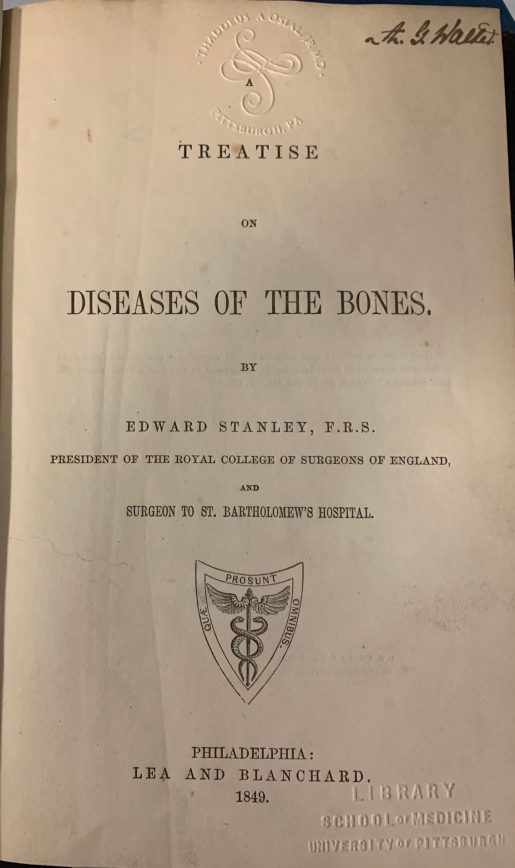A book’s subject matter and significance to a medical historical collection are sometimes outshone by the fascinating provenance or story of the material object, the physical copy itself. And such is the case with the work of Edward Stanley, the well-respected surgeon to St. Bartholomew’s Hospital.
The first American edition of Stanley’s “A Treatise on Diseases of the Bones” (Philadelphia, 1849) is a cornerstone of our rheumatism collection. The systematic treatise on bone diseases was anticipated and well received by its 19th-century audience. Falk Library previously owned two copies of this important book. However, in the process of managing collections, one sometimes has to make tough choices. And so, in the late 1970s, the library deduplicated its holdings to make room for new acquisitions. How was it decided which copy should be deaccessioned? Both books had an interesting local provenance. Both were owned and donated to the library by Pitt professors who were instrumental in creating the seed book collection for the School of Medicine in the 19th century. It is difficult now to judge why the selection was made, but at the time, it was the copy from the Dr. Albert G. Walter collection that was chosen for removal from the library. The book then entered the private collectors’ market.

Dr. Walter was a well-known figure in the Pittsburgh medical community. He was an owner of a private hospital and of many interesting books donated to the School of Medicine, some of which became gems of our current rare book collection, as well as the owner of a spectacular collection of several hundred specimens of deformities and calculi, which formed the Albert G. Walter’s Museum in 1886. This was an important resource which became a major highlight of any recruitment efforts in the early years of the Western Pennsylvania Medical College, the predecessor to the School of Medicine. As the story goes, Dr. Walter’s copy of “A Treatise on Diseases of the Bones” left the library and landed in a private collection, enjoying a luxurious life of pampering and admiration by a new owner. Meanwhile, the copy which stayed in the library took all the “abuse” a book can get in a busy library setting during the almost 50-year period that followed: two major makeovers of library spaces, at least three moves of the collection to different areas, patron use and regular reshelving, and fluctuations of temperature and humidity before the HVAC system was installed in 2004. As a result, the library’s copy of Edward Stanley’s work deteriorated and is in a fragile state now.
Fortunately, this is a story with a happy ending, because the volume with Dr. Walter’s provenance returned to the library. What a joy it was to see a perfect copy with familiar ownership markings and Dr. Walter’s signature among Dr. Thaddeus Osial’s donations. Like with a proverbial prodigal son, there cannot be any other reaction but joy and open arms: Welcome back, Stanley. You belong here!
~Małgorzata Fort